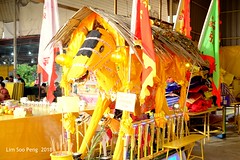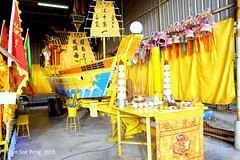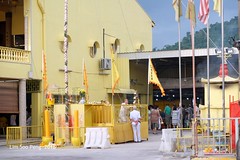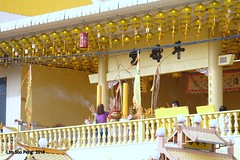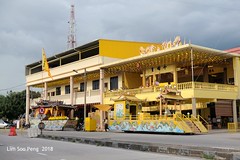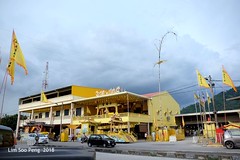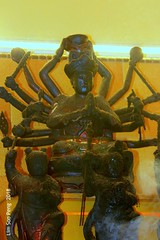Day Five: Solitude & the “Rule of Thirds”
Solitude – The Nyonya’s Prayers.
In olden days, young unmarried nyonyas were only allowed outside the house except for the Chap Goh Meh during Chinese New Year. This is known as the Chinese’s Valentine Day/Night. Solitude and loneliness are thus part of their daily routine. It is the usual tradition for these unmarried nyonyas to throw mandarin oranges to wish for a good husbands in future.
The photograph which I had captioned as ” The Nyonya’s Prayers “ is an optimistic young unmarried Nyonya praying the Jade Emperor of Heaven to grant her wish of a good loving husband soon to end her life of solitude and loneliness. The “Rule of Thirds” is closely followed with the caption added to the photograph.
SP Lim
The internet in our area (Penang, Malaysia) is extremely slow and was lucky to get this portion uploaded. Hopefully it is not related to my complaints in my recent blogs. Please excuse me that I am not able to read the over 100 emails to see your blogs which I am following for the last few days. I shall read in the next few days if the local internet speed permits me to do so. Sorry, again my fellow friends and bloggers.

The Nyonya’s Prayers. In olden days, young unmarried nyonyas were only allowed outside the house except for the Chap Goh Meh during Chinese New Year. This is known as the Chinese’s Valentine Day/Night. Solitude and loneliness are thus part of their daily routine.
From Wikipedia:-
Peranakan Chinese or Straits-born Chinese are the descendants of Chinese immigrants who came to the Malay archipelago including British Malaya (now Peninsular Malaysia and Singapore, where they are also referred to as Baba-Nyonya) and Dutch East Indies (now Indonesia; where they’re also referred as Kiau-Seng) between the 15th and 17th centuries.
Members of this community in Malaysia address themselves as “Baba Nyonya”. Nyonya is the term for the women and Baba for the men. It applies especially to the Han populations of the British Straits Settlements of Malaya and the Dutch-controlled island of Java and other locations, who have adopted Nusantara customs — partially or in full — to be somewhat assimilated into the local communities. Many were the elites of Singapore, more loyal to the British than to China. Most have lived for generations along the straits of Malacca. They were usually traders, the middleman of the British and the Chinese, or the Chinese and Malays, or vice versa because they were mostly English educated. Because of this, they almost always had the ability to speak two or more languages.
While the term Peranakan is most commonly used to refer to those of Chinese descent also known as Straits Chinese (named after the Straits Settlements; 土生華人 in Chinese; Tionghoa-Selat or Tionghoa Peranakan in Indonesian; Phuket Baba among Thais in Phuket, Thailand), there are also other, comparatively smaller Peranakan communities, such as Indian Hindu Peranakans (Chitty), Arab/Indian Muslim Peranakans (Jawi Pekan) (Jawi being the Javanised Arabic script, Pekan a colloquial contraction of Peranakan) and Eurasian Peranakans (Kristang) (Kristang = Christians of Portuguese and Asian ancestry). The group has parallels to the Cambodian Hokkien, who are descendants of Hoklo Chinese, and the Pashu of Myanmar, a Burmese word for the Peranakan or Straits Chinese who have settled in Myanmar. They maintained their culture partially despite their native language gradually disappearing a few generations after settlement.
For My Future Reference:-
Day Five: Solitude & the “Rule of Thirds”
We’re excited about today’s theme, solitude. In addition to thinking about what it means to you, also consider the placement of the subject in your shot. How can you interpret the state of being alone, or a lonely and uninhabited place?
Find inspiration in this shot of Lanikai Beach in Oahu, Hawaii, as a girl sits in the sand.
Photo – not included
Today’s Tip: As you frame your shot, consider the “Rule of Thirds,” which is a great introductory lesson in composition. Divide your shot into thirds, both horizontally and vertically, so you get nine parts. Your camera probably has the option to display this grid in your viewfinder or LCD screen. But if not, envision this atop your frame:
Place your subject at the intersections of these lines, or along them. In the beach shot, the placement of the girl, toward the bottom-right, doesn’t exactly follow this “rule,” but uses the grid as a guide to create an interesting composition — her aloneness is amplified by the open space to the left. This off-center placement also aligns with how our eyes naturally interact with images.
Get inspired by the submissions from Jen Hooks’ Rule of Thirds photo challenge from February 2015.
Rules are meant to be bent and broken, especially since each image is different! Today, experiment with this grid as you frame your solitary subject.
Cheers,
Josh R. and the WordPress.com Team













